Reed Canary Grass for Energy in Sweden: Yields, Land-Use Patterns, and Climatic Profile
Abstract
:1. Introduction
2. Material and Methods
2.1. Data Sources
2.2. Data Analysis
3. Results
4. Discussion
5. Conclusions
Author Contributions
Funding
Data Availability Statement
Acknowledgments
Conflicts of Interest
References
- Lewandowski, I.; Scurlock, J.M.; Lindvall, E.; Christou, M. The development and current status of perennial rhizomatous grasses as energy crops in the US and Europe. Biomass Bioenergy 2003, 25, 335–361. [Google Scholar] [CrossRef]
- Antonkiewicz, J.; Kołodziej, B.; Bielińska, E.J. The use of reed canary grass and giant miscanthus in the phytoremediation of municipal sewage sludge. Environ. Sci. Pollut. Res. 2016, 23, 9505–9517. [Google Scholar] [CrossRef]
- Lavergne, S.; Molofsky, J. Reed canary grass (Phalaris arundinacea) as a biological model in the study of plant invasions. Crit. Rev. Plant Sci. 2004, 23, 415–429. [Google Scholar] [CrossRef]
- Englund, O.; Börjesson, P.; Berndes, G.; Scarlat, N.; Dallemand, J.F.; Grizzetti, B.; Dimitriou, I.; Mola-Yudego, B.; Fahl, F. Beneficial land use change: Strategic expansion of new biomass plantations can reduce environmental impacts from EU agriculture. Glob. Environ. Chang. 2020, 60, 101990. [Google Scholar] [CrossRef]
- Jasinskas, A.; Streikus, D.; Šarauskis, E.; Palšauskas, M.; Venslauskas, K. Energy evaluation and greenhouse gas emissions of reed plant pelletizing and utilization as solid biofuel. Energies 2020, 13, 1516. [Google Scholar] [CrossRef] [Green Version]
- Roj-Rojewski, S.; Wysocka-Czubaszek, A.; Czubaszek, R.; Kamocki, A.; Banaszuk, P. Anaerobic digestion of wetland biomass from conservation management for biogas production. Biomass Bioenergy 2019, 122, 126–132. [Google Scholar] [CrossRef]
- Tilvikiene, V.; Kadziuliene, Z.; Dabkevicius, Z.; Venslauskas, K.; Navickas, K. Feasibility of tall fescue, cocksfoot and reed canary grass for anaerobic digestion: Analysis of productivity and energy potential. Ind. Crop. Prod. 2016, 84, 87–96. [Google Scholar] [CrossRef]
- Alhumade, H.; da Silva, J.C.G.; Ahmad, M.S.; Çakman, G.; Yıldız, A.; Ceylan, S.; Elkamel, A. Investigation of pyrolysis kinetics and thermal behavior of Invasive Reed Canary (Phalaris arundinacea) for bioenergy potential. J. Anal. Appl. Pyrolysis 2019, 140, 385–392. [Google Scholar] [CrossRef]
- Scordia, D.; Cosentino, S.L. Perennial energy grasses: Resilient crops in a changing European agriculture. Agriculture 2019, 9, 169. [Google Scholar] [CrossRef] [Green Version]
- Lankoski, J.; Ollikainen, M. Bioenergy crop production and climate policies: A von Thunen model and the case of reed canary grass in Finland. Eur. Rev. Agric. Econ. 2008, 35, 519–546. [Google Scholar] [CrossRef]
- Mikkola, H.J.; Ahokas, J. Renewable energy from agro biomass. Agron. Res. 2011, 9, 159–164. [Google Scholar]
- Pahkala, K.; Aalto, M.; Isolahti, M.; Poikola, J.; Jauhiainen, L. Large-scale energy grass farming for power plants—A case study from Ostrobothnia, Finland. Biomass Bioenergy 2008, 32, 1009–1015. [Google Scholar] [CrossRef]
- Larsson, S. Supply curves of reed canary grass (Phalaris arundinacea L.) in Västerbotten County, northern Sweden, under different EU subsidy schemes. Biomass Bioenergy 2006, 30, 28–37. [Google Scholar] [CrossRef]
- Nilsson, D.; Rosenqvist, H.; Bernesson, S. Profitability of the production of energy grasses on marginal agricultural land in Sweden. Biomass Bioenergy 2015, 83, 159–168. [Google Scholar] [CrossRef] [Green Version]
- Alway, F.J. Early trials and use of reed-canary grass as a forage plant. J. Am. Soc. Agron. 1931, 23, 64–66. [Google Scholar] [CrossRef]
- Finell, M. The Use of Reed Canary-Grass (Phalaris arundinacea) as a Short Fibre Raw Material for the Pulp and Paper Industry. Ph.D. Thesis, Swedish University of Agricultural Sciences, Umeå, Sweden, 2003. Available online: http://urn.kb.se/resolve?urn=urn:nbn:se:slu:epsilon-95 (accessed on 16 January 2021).
- Landfors, K.; Hollsten, R. Energigräs–en Kunskapssammanställning; Jordbruksverket: Jönköping, Sweden, 2011; 20p. (In Swedish) [Google Scholar]
- Landström, S.; Lomakka, L.; Andersson, S. Harvest in spring improves yield and quality of reed canary grass as a bioenergy crop. Biomass Bioenergy 1996, 11, 333–341. [Google Scholar] [CrossRef]
- Venendaal, R.; Jørgensen, U.; Foster, C.A. European energy crops: A synthesis. Biomass Bioenergy 1997, 13, 147–185. [Google Scholar] [CrossRef]
- Shield, I.F.; Barraclough, T.J.P.; Riche, A.B.; Yates, N.E. The yield response of the energy crops switchgrass and reed canary grass to fertiliser applications when grown on a low productivity sandy soil. Biomass Bioenergy 2012, 42, 86–96. [Google Scholar] [CrossRef]
- Lindvall, E. Nutrient Supply to Reed Canary Grass as a Bioenergy Crop. Acta Univ. Agric. Suec. 2014, 54, 53. [Google Scholar]
- Lewandowski, I. Biomass Production from Lignocellulosic Energy Crops. In Encyclopedia of Applied Plant Sciences; Thomas, B., Murray, B.G., Murphy, D.J., Eds.; Elsevier: Amsterdam, Netherlands, 2017; pp. 159–163. ISBN 978-0-12-394808-3. [Google Scholar]
- Lindvall, E.; Gustavsson, A.M.; Samuelsson, R.; Magnusson, T.; Palmborg, C. Ash as a phosphorus fertilizer to reed canary grass: Effects of nutrient and heavy metal composition on plant and soil. GCB Bioenergy 2015, 7, 553–564. [Google Scholar] [CrossRef]
- Pahkala, K.; Partala, A.; Suokannas, A.; Klemola, E.; Kalliomäki, T.; Kirkkari, A.M.; Flyktman, M. Odling och Skörd av Rörflen för Energiproduktion; MTT: Jokioinen, Finland, 2003; 27p, ISBN 951-729-744-0. (In Swedish) [Google Scholar]
- Lindvall, E.; Gustavsson, A.M.; Palmborg, C. Establishment of reed canary grass with perennial legumes or barley and different fertilization treatments: Effects on yield, botanical composition and nitrogen fixation. GCB Bioenergy 2012, 4, 661–670. [Google Scholar] [CrossRef]
- Kandel, T.P.; Elsgaard, L.; Karki, S.; Lærke, P.E. Biomass yield and greenhouse gas emissions from a drained fen peatland cultivated with reed canary grass under different harvest and fertilizer regimes. BioEnergy Res. 2013, 6, 883–895. [Google Scholar] [CrossRef]
- Xiong, S.; Zhang, Q.G.; Zhang, D.Y.; Olsson, R. Influence of harvest time on fuel characteristics of five potential energy crops in northern China. Bioresour. Technol. 2008, 99, 479–485. [Google Scholar] [CrossRef] [PubMed]
- Larsson, S.H.; Thyrel, M.; Geladi, P.; Lestander, T.A. High quality biofuel pellet production from pre-compacted low density raw materials. Bioresour. Technol. 2008, 99, 7176–7182. [Google Scholar] [CrossRef] [PubMed]
- JBB, Swedish Board of Agriculture (Jordbruksverket). Kartor och Geografiska Informations System. Available online: https://nya.jordbruksverket.se/ (accessed on 20 November 2019). (In Swedish).
- Xu, X.; Mola-Yudego, B. Where and when are plantations established? Land-use replacement patterns of fast-growing plantations on agricultural land. Biomass Bioenergy 2021, 144, 105921. [Google Scholar] [CrossRef]
- Mola-Yudego, B.; Díaz-Yáñez, O.; Dimitriou, I. How much yield should we expect from fast-growing plantations for energy? Divergences between experiments and commercial willow plantations. BioEnergy Res. 2015, 8, 1769–1777. [Google Scholar] [CrossRef]
- Dimitriou, I.; Mola-Yudego, B. Poplar and willow plantations on agricultural land in Sweden: Area, yield, groundwater quality and soil organic carbon. For. Ecol. Manag. 2017, 383, 99–107. [Google Scholar] [CrossRef]
- Eurostat 2021, Crop Production in EU Standard Humidity, Code: Apro_cpsh1. Available online: https://ec.europa.eu/eurostat (accessed on 6 April 2021).
- LUKE 2021, Natural Resources Institute Finland, Statistical Databases, Crop Production Statistics, Luke_Maa_Sato_0. Available online: www.statdb.luke.fi (accessed on 6 April 2021).
- Swedish Official Statistics, Standard Yields for Yield Survey Districts, Counties and the Whole Country, Several years). Available online: https://www.scb.se (accessed on 23 October 2019). (In Swedish).
- Fick, S.E.; Hijmans, R.J. WorldClim 2: New 1--km spatial resolution climate surfaces for global land areas. Int. J. Climatol. 2017, 37, 4302–4315. [Google Scholar] [CrossRef]
- Worton, B.J. Kernel methods for estimating the utilization distribution in home-range studies. Ecology 1989, 70, 164–168. [Google Scholar] [CrossRef]
- Silverman, B.W. Density Estimation for Statistics and DATA Analysi; CRC Press: Boca Raton, FL, USA, 1986; Volume 26. [Google Scholar]
- Mola-Yudego, B.; González-Olabarria, J.R. Mapping the expansion and distribution of willow plantations for bioenergy in Sweden: Lessons to be learned about the spread of energy crops. Biomass Bioenergy 2010, 34, 442–448. [Google Scholar] [CrossRef]
- Jordbruksverket. Stöd för Odling av Grödor för Industri- och Energiändamål; Jönköping, Sweden, 2008; 24p, Available online: http://www2.jordbruksverket.se/webdav/files/SJV/trycksaker/Jordbruksstod/JS13.pdf (accessed on 26 January 2021). (In Swedish)
- Hadders, G.; Olssen, R. European Energy Crops Overview, Country Report for Sweden. 1996. Available online: https://www.diva-portal.org/smash/get/diva2:959639/FULLTEXT01.pdf (accessed on 26 January 2021).
- Mola-Yudego, B.; Pelkonen, P. The effects of policy incentives in the adoption of willow short rotation coppice for bioenergy in Sweden. Energy Policy 2008, 36, 3062–3068. [Google Scholar] [CrossRef]
- Official Journal of the European Union. Communication from the Commission to All Farmers Concerning Set Aside from 2009 (2008/C 324/07). 2008. Available online: https://eur-lex.europa.eu/LexUriServ/LexUriServ.do?uri=OJ:C:2008:324:0011:0011:EN:PDF (accessed on 26 January 2021).
- Pahkala, K.; Pihala, M. Different plant parts as raw material for fuel and pulp production. Ind. Crop. Prod. 2000, 11, 119–128. [Google Scholar] [CrossRef]
- Heinsoo, K.; Hein, K.; Melts, I.; Holm, B.; Ivask, M. Reed canary grass yield and fuel quality in Estonian farmers’ fields. Biomass Bioenergy 2001, 35, 617–625. [Google Scholar] [CrossRef]
- Jasinskas, A.; Zaltauskas, A.; Kryzeviciene, A. The investigation of growing and using of tall perennial grasses as energy crops. Biomass Bioenergy 2008, 32, 981–987. [Google Scholar] [CrossRef]
- Lötjönen, T.; Paappanen, T. Bale density of reed canary grass spring harvest. Biomass Bioenergy 2013, 51, 53–59. [Google Scholar] [CrossRef]
- Mola-Yudego, B.; Aronsson, P. Yield models for commercial willow biomass plantations in Sweden. Biomass Bioenergy 2008, 32, 829–837. [Google Scholar] [CrossRef]
- Paulrud, S.; Laitila, T. Farmers’ attitudes about growing energy crops: A choice experiment approach. Biomass Bioenergy 2010, 34, 1770–1779. [Google Scholar] [CrossRef]
- Börjesson, P. Environmental effects of energy crop cultivation in Sweden—I: Identification and quantification. Biomass Bioenergy 1999, 16, 137–154. [Google Scholar] [CrossRef]
- TIKE. Yearbook of Farm Statistics, Utilized Agricultural Area, 2001–2007; ISSN: Helsinki, Finland, 2007. [Google Scholar]
- Lindh, T.; Paappanen, T.; Rinne, S.; Sivonen, K.; Wihersaari, M. Reed canary grass transportation costs—Reducing costs and increasing feasible transportation distances. Biomass Bioenergy 2009, 33, 209–212. [Google Scholar] [CrossRef]
- Larsson, S.; Nilsson, C. A remote sensing methodology to assess the costs of preparing abandoned farmland for energy crop cultivation in northern Sweden. Biomass Bioenergy 2005, 28, 1–6. [Google Scholar] [CrossRef]
- Olsson, J.; Salomon, E.; Baky, E.; Palm, O. Energigrödor–en Möjlighet för Jordbruksanvändning av Slam; Svenskt Vatten Utveckling, Svenskt Vatten AB: Bromma, Sweden, 2008; Volume 12, p. 53. (In Swedish) [Google Scholar]
- MMM, (Ministry of Agriculture and Forestry). Press Release Interim Report. 2006. Available online: https://mmm.fi/sv/-/ruokohelven-viljelyala-noussut-nopeasti-suomessa (accessed on 26 January 2006).
- Hyvönen, N.P.; Huttunen, J.T.; Shurpali, N.J.; Tavi, N.M.; Repo, M.E.; Martikainen, P.J. Fluxes of nitrous oxide and methane on an abandoned peat extraction site: Effect of reed canary grass cultivation. Bioresour. Technol. 2009, 100, 4723–4730. [Google Scholar] [CrossRef] [PubMed]
- Burvall, J. Influence of harvest time and soil type on fuel quality in reed canary grass (Phalaris arundinacea L.). Biomass Bioenergy 1997, 12, 149–154. [Google Scholar] [CrossRef]
- Xiong, S.; Kätterer, T. Carbon-allocation dynamics in reed canary grass as affected by soil type and fertilization rates in northern Sweden. Acta Agric. Scand. Sect. B Soil Plant Sci. 2010, 60, 24–32. [Google Scholar] [CrossRef]
- Shurpali, N.J.; Hyvönen, N.P.; Huttunen, J.T.; Clement, R.J.; Reichstein, M.; Nykänen, H.; Nykänen, H.; Biasi, C.; Martikainen, P.J. Cultivation of a perennial grass for bioenergy on a boreal organic soil–carbon sink or source? GCB Bioenergy 2009, 1, 35–50. [Google Scholar] [CrossRef]
- Krol, D.J.; Jones, M.B.; Williams, M.; Choncubhair, O.N.; Lanigan, G.J. The effect of land use change from grassland to bioenergy crops Miscanthus and reed canary grass on nitrous oxide emissions. Biomass Bioenergy 2019, 120, 396–403. [Google Scholar] [CrossRef]
- Spyreas, G.; Wilm, B.W.; Plocher, A.E.; Ketzner, D.M.; Matthews, J.W.; Ellis, J.L.; Heske, E.J. Biological consequences of invasion by reed canary grass (Phalaris arundinacea). Biol. Invasions 2010, 12, 1253–1267. [Google Scholar] [CrossRef]
- Hersperger, A.M. Spatial adjacencies and interactions: Neighborhood mosaics for landscape ecological planning. Landsc. Urban Plan. 2006, 77, 227–239. [Google Scholar] [CrossRef]
- Englund, O.; Börjesson, P.; Mola-Yudego, B.; Berndes, G.; Dimitriou, I.; Cederberg, C.; Scarlat, N. Beneficial Land-Use Change in Europe: Deployment Scenarios for Multifunctional Riparian Buffers and Windbreaks. 2021. Available online: https://www.researchsquare.com/article/rs-128604/v1 (accessed on 10 May 2021). [CrossRef]
- Englund, O.; Dimitriou, I.; Dale, V.H.; Kline, K.L.; Mola-Yudego, B.; Murphy, F.; English, B.; McGrath, J.; Busch, G.; Negri, M.C.; et al. Multifunctional perennial production systems for bioenergy: Performance and progress. Wiley Interdiscip. Rev. Energy Environ. 2020, 9, e375. [Google Scholar] [CrossRef]
- Mander, Ü.; Järveoja, J.; Maddison, M.; Soosaar, K.; Aavola, R.; Ostonen, I.; Salm, J.O. Reed canary grass cultivation mitigates greenhouse gas emissions from abandoned peat extraction areas. GCB Bioenergy 2012, 4, 462–474. [Google Scholar] [CrossRef] [Green Version]

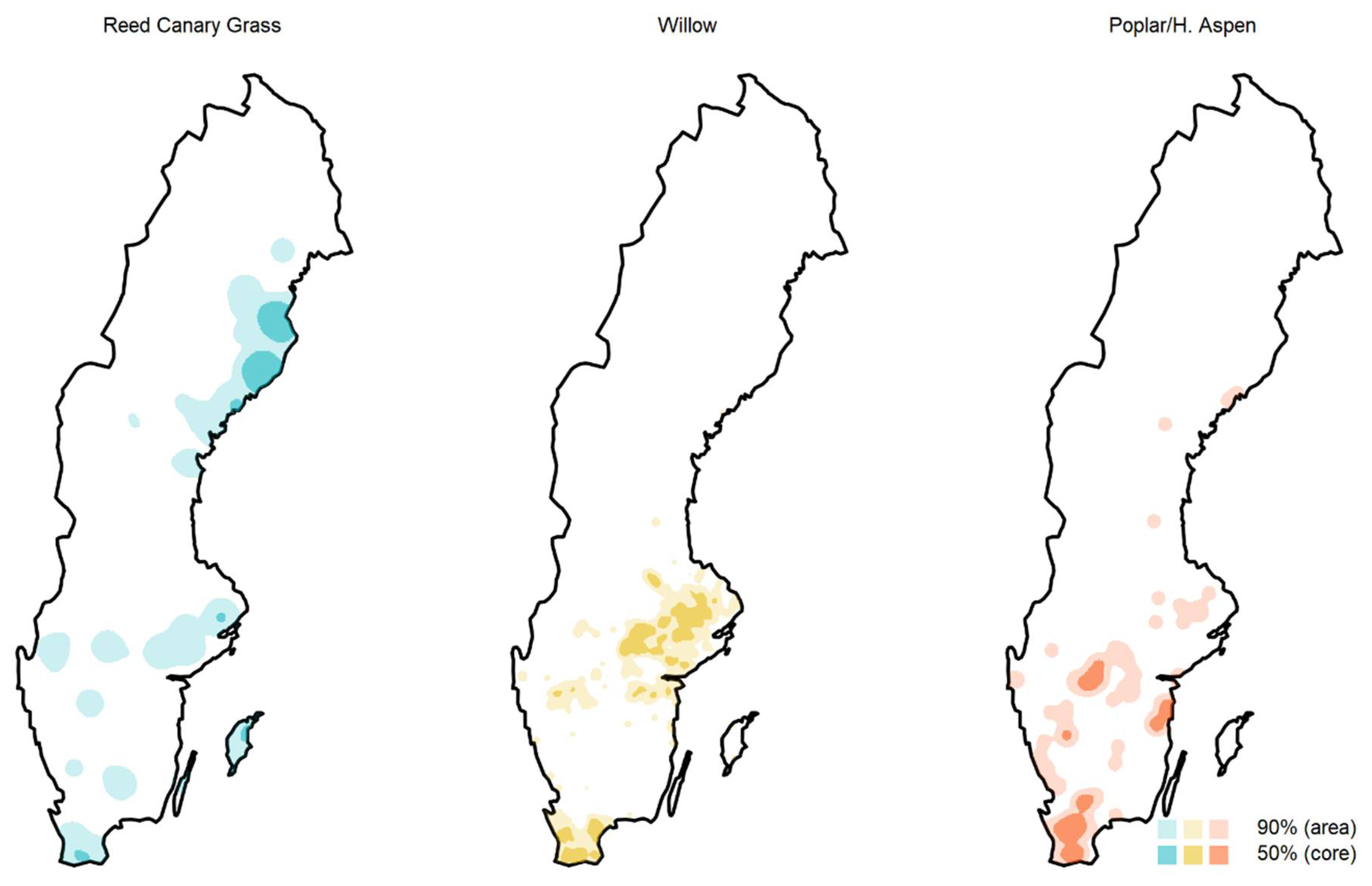
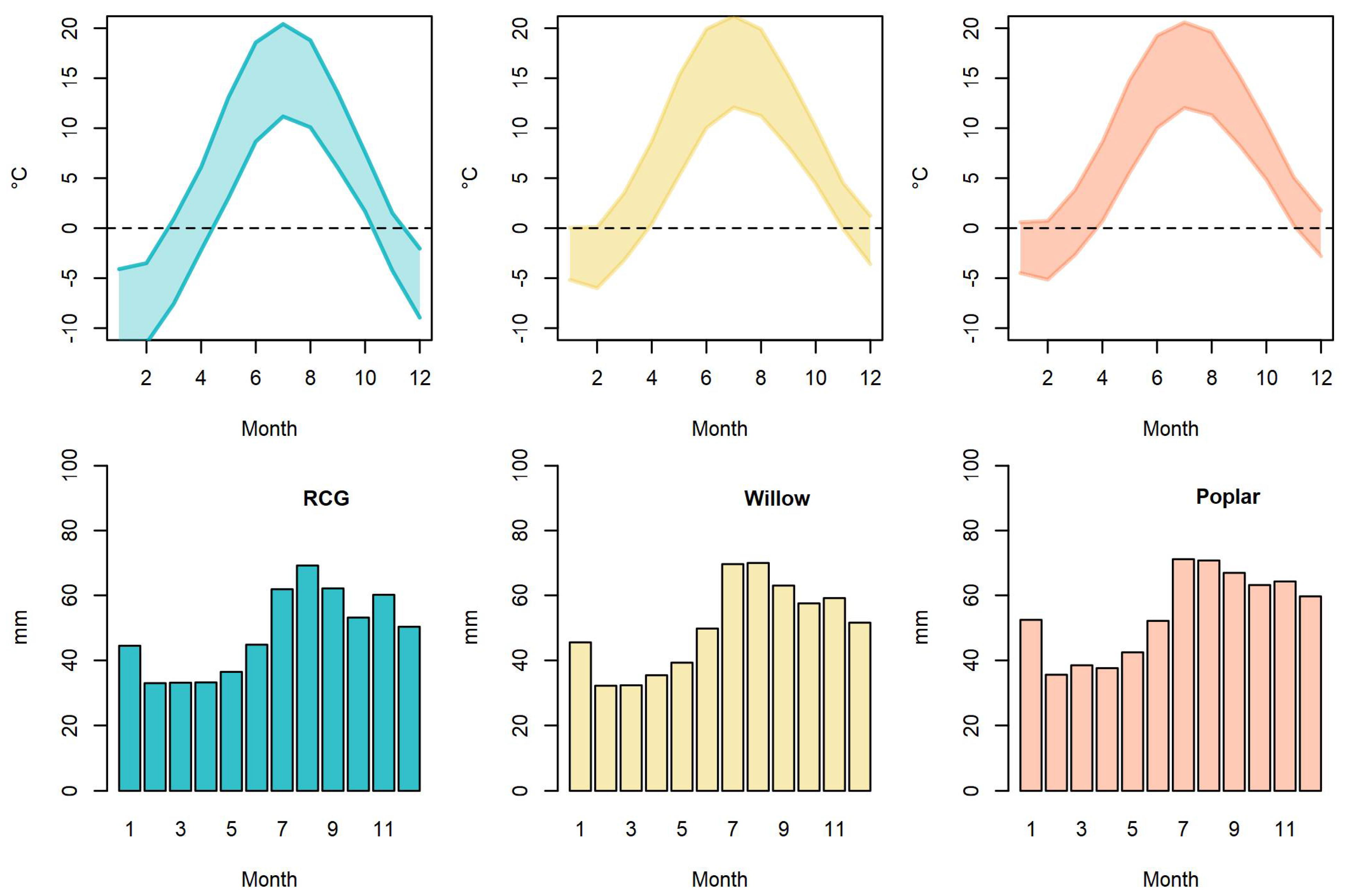
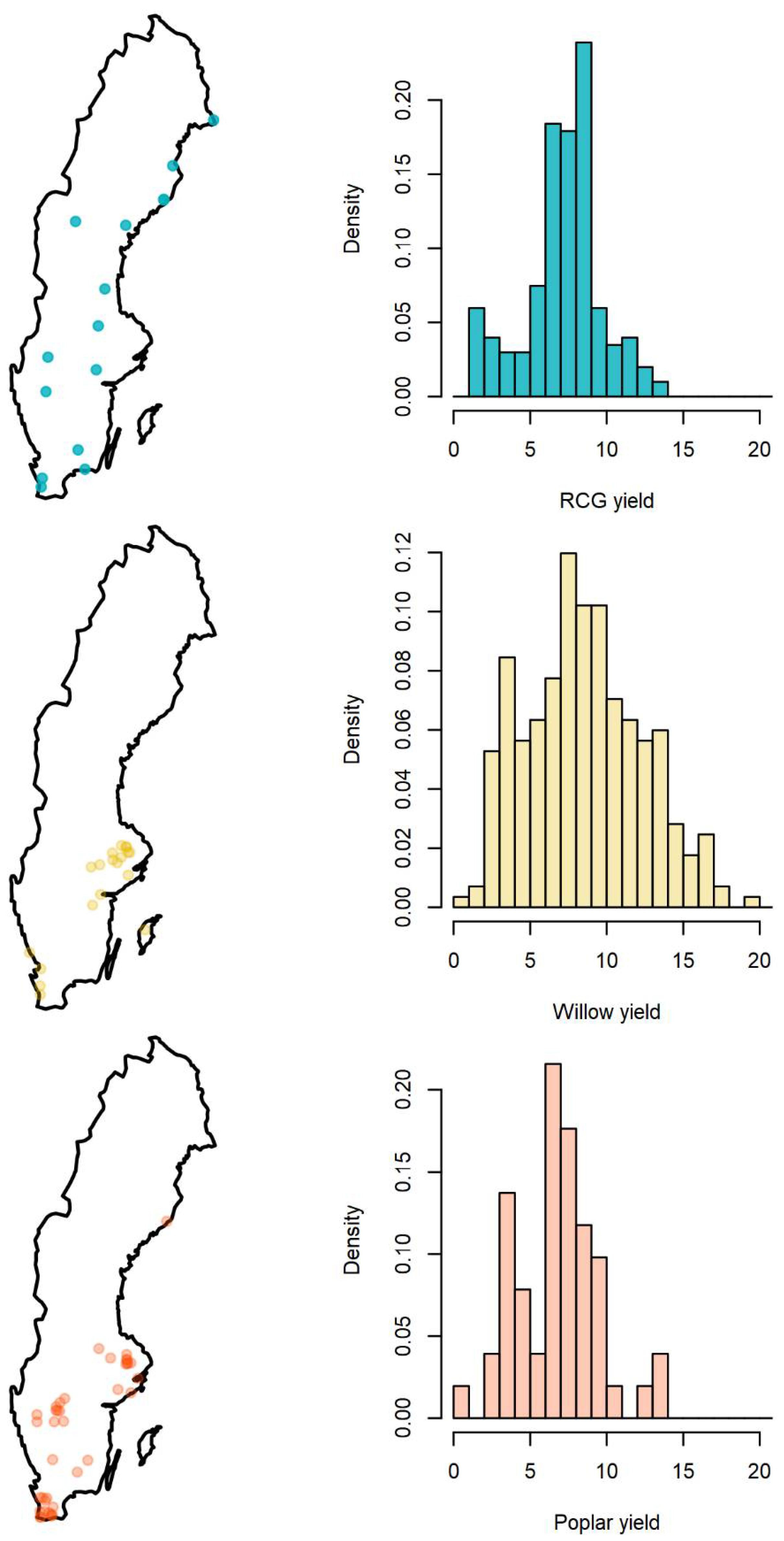
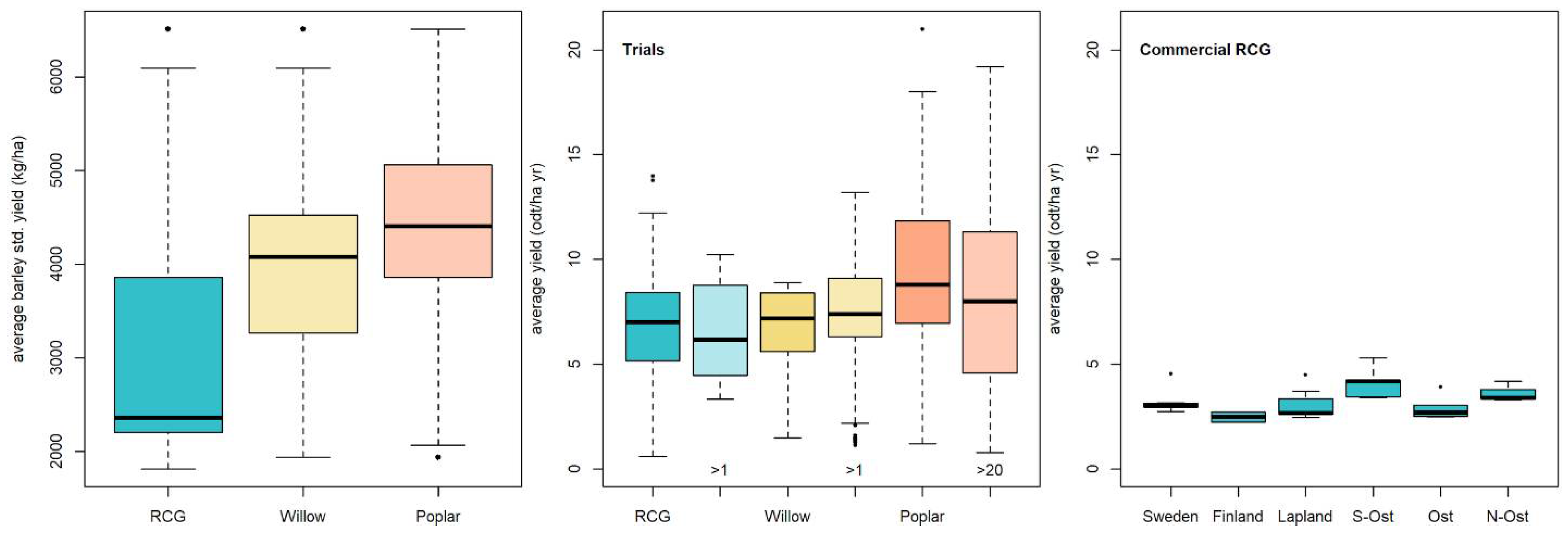
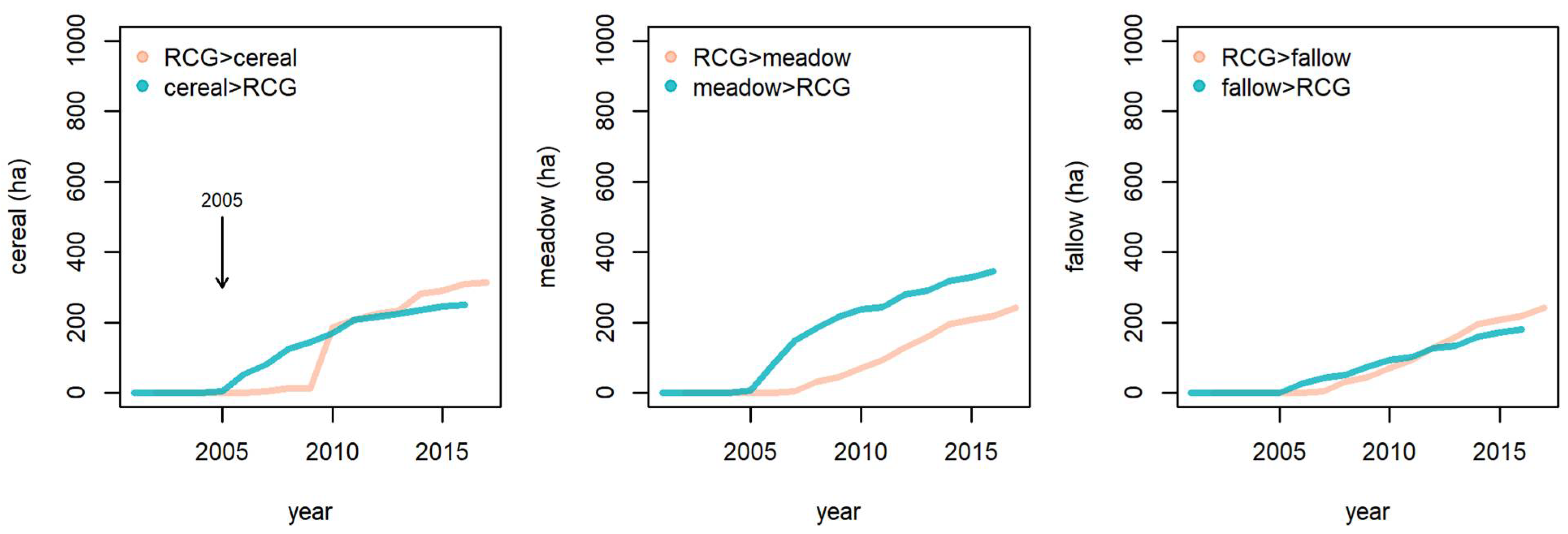
Publisher’s Note: MDPI stays neutral with regard to jurisdictional claims in published maps and institutional affiliations. |
© 2021 by the authors. Licensee MDPI, Basel, Switzerland. This article is an open access article distributed under the terms and conditions of the Creative Commons Attribution (CC BY) license (https://creativecommons.org/licenses/by/4.0/).
Share and Cite
Mola-Yudego, B.; Xu, X.; Englund, O.; Dimitriou, I. Reed Canary Grass for Energy in Sweden: Yields, Land-Use Patterns, and Climatic Profile. Forests 2021, 12, 897. https://doi.org/10.3390/f12070897
Mola-Yudego B, Xu X, Englund O, Dimitriou I. Reed Canary Grass for Energy in Sweden: Yields, Land-Use Patterns, and Climatic Profile. Forests. 2021; 12(7):897. https://doi.org/10.3390/f12070897
Chicago/Turabian StyleMola-Yudego, Blas, Xiaoqian Xu, Oskar Englund, and Ioannis Dimitriou. 2021. "Reed Canary Grass for Energy in Sweden: Yields, Land-Use Patterns, and Climatic Profile" Forests 12, no. 7: 897. https://doi.org/10.3390/f12070897
APA StyleMola-Yudego, B., Xu, X., Englund, O., & Dimitriou, I. (2021). Reed Canary Grass for Energy in Sweden: Yields, Land-Use Patterns, and Climatic Profile. Forests, 12(7), 897. https://doi.org/10.3390/f12070897







